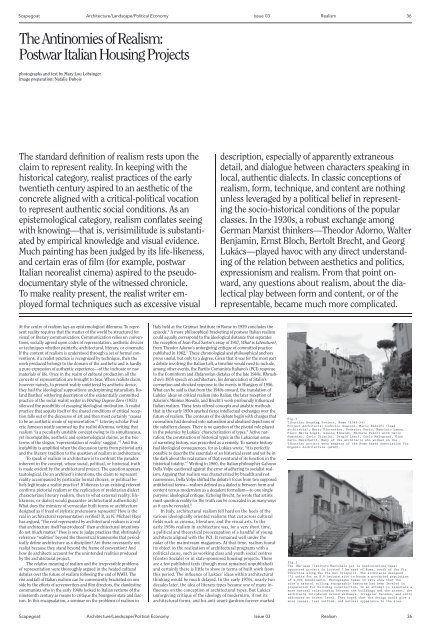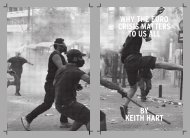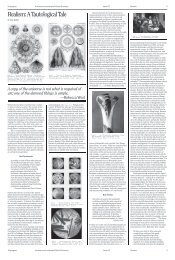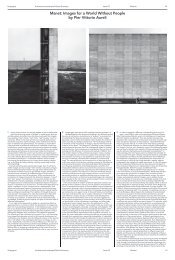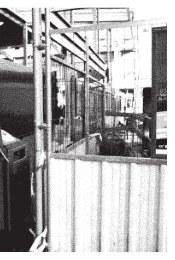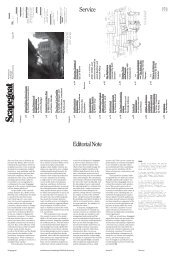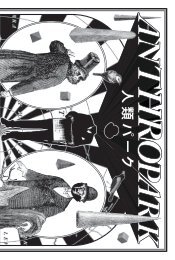Mary Lou LOBSINGER, The Antinomies of Realism - Scapegoat
Mary Lou LOBSINGER, The Antinomies of Realism - Scapegoat
Mary Lou LOBSINGER, The Antinomies of Realism - Scapegoat
You also want an ePaper? Increase the reach of your titles
YUMPU automatically turns print PDFs into web optimized ePapers that Google loves.
<strong>Scapegoat</strong> Architecture/Landscape/Political Economy<br />
Issue 03 <strong>Realism</strong><br />
<strong>The</strong> <strong>Antinomies</strong> <strong>of</strong> <strong>Realism</strong>:<br />
Postwar Italian Housing Projects<br />
photographs and text by <strong>Mary</strong> <strong>Lou</strong> Lobsinger<br />
image preparation: Natalie Dubois<br />
<strong>The</strong> standard definition <strong>of</strong> realism rests upon the<br />
claim to represent reality. In keeping with the<br />
historical category, realist practices <strong>of</strong> the early<br />
twentieth century aspired to an aesthetic <strong>of</strong> the<br />
concrete aligned with a critical-political vocation<br />
to represent authentic social conditions. As an<br />
epistemo logical category, realism conflates seeing<br />
with knowing—that is, verisimilitude is substantiated<br />
by empirical knowledge and visual evidence.<br />
Much painting has been judged by its life-likeness,<br />
and certain eras <strong>of</strong> film (for example, postwar<br />
Italian neorealist cinema) aspired to the pseudo-<br />
documentary style <strong>of</strong> the witnessed chronicle.<br />
To make reality present, the realist writer employed<br />
formal techniques such as excessive visual<br />
At the centre <strong>of</strong> realism lays an epistemological dilemma. To represent<br />
reality requires that the matter <strong>of</strong> the world be structured for<br />
visual or literary communication. Communication relies on conventions,<br />
socially agreed upon codes <strong>of</strong> representation, aesthetic devices<br />
or techniques whether painterly, architectural, literary, or cinematic.<br />
If the content <strong>of</strong> realism is understood through a set <strong>of</strong> formal conventions,<br />
if a realist practice is recognized by technique, then the<br />
work produced belongs to the domain <strong>of</strong> the aesthetic and is hardly<br />
a pure expression <strong>of</strong> authentic experience—<strong>of</strong> the inchoate or raw<br />
materials <strong>of</strong> life. Once in the realm <strong>of</strong> cultural production all the<br />
conceits <strong>of</strong> representation are brought to bear. When realists claim,<br />
however naively, to present reality unfettered by aesthetic device,<br />
they hail the ideological suppositions underpinning naturalism. Roland<br />
Barthes’ withering description <strong>of</strong> the existentially committed<br />
practice <strong>of</strong> the social realist writer in Writing Degree Zero (1953)<br />
silenced the possibility <strong>of</strong> escaping ideological motivation. A realist<br />
practice that acquits itself <strong>of</strong> the shared conditions <strong>of</strong> critical reception<br />
falls out <strong>of</strong> the discourse <strong>of</strong> art and then most certainly “ceases<br />
to be an aesthetic mode <strong>of</strong> representation.” 1 Literary scholar Frederic<br />
Jameson neatly summed up the realist dilemma, writing that<br />
realism “is a peculiarly unstable concept owing to its simultaneous,<br />
yet incompatible, aesthetic and epistemological claims, as the two<br />
terms <strong>of</strong> the slogan, ‘representation <strong>of</strong> reality’ suggest.” 2 And this<br />
instability is amplified when the discussion turns from pictorial arts<br />
and the literary tradition to the question <strong>of</strong> realism in architecture.<br />
To speak <strong>of</strong> realism in architecture is to confront the paradox<br />
inherent in the concept, whose social, political, or historical truth<br />
is made evident by the architectural project. <strong>The</strong> question appears<br />
tautological. Do an architect’s intentions, the claim to represent<br />
reality accompanied by particular formal choices, or political beliefs<br />
legitimate a realist practice? If likeness to an existing referent<br />
confirms pictorial realism or the replication <strong>of</strong> proletarian dialect<br />
characterizes literary realism, then to what external reality, lifelikeness,<br />
or dialect would guarantee architectural authenticity?<br />
What does the mimicry <strong>of</strong> vernacular built forms or architecture<br />
designed as if freed <strong>of</strong> stylistic pretensions represent? How is the<br />
real in architectural representation verified? If, as K. Michael Hays<br />
has argued, “the real represented by architectural realism is a real<br />
that architecture itself has produced” then architectural intentions<br />
do not much matter. 3 How is one to judge practices that obstinately<br />
reference “realities” beyond the theoretical frameworks that periodically<br />
define architecture as a discipline? Are these necessarily not<br />
realist because they stand beyond the frame <strong>of</strong> convention? And<br />
how do architects account for the unintended realities produced<br />
by the architectural project.<br />
<strong>The</strong> relative meaning <strong>of</strong> realism and the irrepressible problems<br />
<strong>of</strong> representation were thoroughly argued in the heated cultural<br />
debates over the future <strong>of</strong> realism following the end <strong>of</strong> WWII. <strong>The</strong><br />
rise and fall <strong>of</strong> Italian realism can be conveniently bracketed on one<br />
side by the efforts <strong>of</strong> screenwriters and film directors, the clandestine<br />
communists who in the early 1940s looked to Italian verismo <strong>of</strong> the<br />
nineteenth century as means to critique the bourgeois state and fascism.<br />
In this encapsulation, a seminar on the problems <strong>of</strong> realism in<br />
Italy held at the Gramsci Institute in Rome in 1959 concludes the<br />
episode. 4 A more philosophical bracketing <strong>of</strong> postwar Italian realism<br />
could equally correspond to the ideological distance that separates<br />
the reception <strong>of</strong> Jean-Paul Sartre’s essay <strong>of</strong> 1947, What is Literature?,<br />
from <strong>The</strong>odor Adorno’s unforgiving critique <strong>of</strong> committed practice<br />
published in 1962. 5 <strong>The</strong>se chronological and philosophical anchors<br />
prove useful, but only to a degree. Given that it was for the most part<br />
a debate involving the Italian Left, a timeline would need to include,<br />
among other events, the Partito Comunista Italiano’s (PCI) response<br />
to the Cominform and Zhdanovian dictates <strong>of</strong> the late 1940s, Khrushchev’s<br />
1954 speech on architecture, his denunciation <strong>of</strong> Stalin’s<br />
corruption and shocked response to the events in Hungary <strong>of</strong> 1956.<br />
What can be said is that from the 1940s onward, the translation <strong>of</strong><br />
Lukács’ ideas on critical realism into Italian, the later reception <strong>of</strong><br />
Adorno’s Minima Moralia, and Brecht’s work pr<strong>of</strong>oundly influenced<br />
Italian realism. <strong>The</strong>se texts <strong>of</strong>fered concepts and analytic methods<br />
that in the early 1950s sparked fierce intellectual exchanges over the<br />
future <strong>of</strong> realism. <strong>The</strong> contours <strong>of</strong> the debate begin with charges that<br />
neorealism had devolved into naturalism and idealized depictions <strong>of</strong><br />
the subaltern classes. <strong>The</strong>re is no question <strong>of</strong> the pivotal role played<br />
in the polemics by Lukács’ characterization <strong>of</strong> types. 6 Active narration,<br />
the construction <strong>of</strong> historical types in the Lukácsian sense<br />
<strong>of</strong> narrating history, was prescribed as a remedy. To narrate history<br />
had ideological consequences, for as Lukács wrote, “it is perfectly<br />
possible to describe the essentials <strong>of</strong> an historical event and yet be in<br />
the dark about the real nature <strong>of</strong> that event and <strong>of</strong> its function in the<br />
historical totality.” 7 Writing in 1960, the Italian philosopher Galvano<br />
Della Volpe cautioned against the error <strong>of</strong> adhering to socialist realism.<br />
Arguing that realism was characterized by breadth and not<br />
narrowness, Della Volpe shifted the debate’s focus from two supposed<br />
antithetical terms—realism defined as a dialectic between form and<br />
content versus modernism as a decadent formalism—to one single<br />
purpose: ideological critique. Echoing Brecht, he wrote that artists<br />
must question reality for the truth can be concealed in as many ways<br />
as it can be revealed. 8<br />
In Italy, architectural realism fell hard on the heels <strong>of</strong> the<br />
various ideologically oriented realisms that cut across cultural<br />
fields such as cinema, literature, and the visual arts. In the<br />
early 1950s realism in architecture was, for a very short time,<br />
a political and theoretical preoccupation <strong>of</strong> a handful <strong>of</strong> young<br />
architects aligned with the PCI. It remained well under the<br />
radar <strong>of</strong> the mainstream magazines. At that time, realism found<br />
its object in the realization <strong>of</strong> architectural programs with a<br />
political cause, such as working class and youth social centres<br />
(Centro Sociale) or in state-sponsored housing projects. <strong>The</strong>re<br />
are a few published texts (though most remained unpublished)<br />
and certainly there is little to show in terms <strong>of</strong> built work from<br />
this period. <strong>The</strong> influence <strong>of</strong> Lukács’ ideas within architectural<br />
thinking would be much delayed. In the early 1970s, nearly two<br />
decades later, the idea <strong>of</strong> literary types became one <strong>of</strong> many influences<br />
on the conception <strong>of</strong> architectural types. But Lukács’<br />
unforgiving critique <strong>of</strong> the ideology <strong>of</strong> modernism, if not its<br />
architectural forms, and his anti-avant-gardism forever marked<br />
description, especially <strong>of</strong> apparently extraneous<br />
detail, and dialogue between characters speaking in<br />
local, authentic dialects. In classic conceptions <strong>of</strong><br />
realism, form, technique, and content are nothing<br />
unless leveraged by a political belief in representing<br />
the socio-historical conditions <strong>of</strong> the popular<br />
classes. In the 1930s, a robust exchange among<br />
German Marxist thinkers—<strong>The</strong>odor Adorno, Walter<br />
Benjamin, Ernst Bloch, Bertolt Brecht, and Georg<br />
Lukács—played havoc with any direct understanding<br />
<strong>of</strong> the relation between aesthetics and politics,<br />
expressionism and realism. From that point onward,<br />
any questions about realism, about the dia -<br />
lectical play between form and content, or <strong>of</strong> the<br />
representable, became much more complicated.<br />
<strong>Scapegoat</strong> Architecture/Landscape/Political Economy<br />
Issue 03 <strong>Realism</strong><br />
Fig. 1<br />
Tiburtino Housing Project, Rome (1949-54)<br />
Project Architects: Ludovico Quaroni, Mario Ridolfi (lead<br />
architects); Mario Fiorentino, Federico Gorio, Maurizio Lanza,<br />
Piero Maria Lugli, Giulio Rinaldi, Michele Valori with Carlo<br />
Aymonino, Carlo Chiarini, Sergio Lenci, Carlo Melograni, Gian<br />
Carlo Menichetti. Many <strong>of</strong> the architects who worked on the<br />
Tiburtino project were members <strong>of</strong> the Rome-based Association for<br />
Organic Architecture (APAO).<br />
36<br />
Fig. 2<br />
<strong>The</strong> INA-Casa (Istituto Nazionale per le Assicurazione-Casa)<br />
sponsored project is located 7 km east <strong>of</strong> Rome, south <strong>of</strong> the Via<br />
Tiburtina along the Via Dei Crispolti. <strong>The</strong> architects designed<br />
771 units for an 8.8-hectare site to house a projected population<br />
<strong>of</strong> 4,000 inhabitants. Photographs taken in 1954 show that the<br />
site’s natural rolling topographic features had been leveled in<br />
preparation for building construction. In an attempt to reinstate a<br />
more natural relationship between the buildings and the street, the<br />
architects introduced raised walkways, irregular facades, and entry<br />
addresses at street level. <strong>The</strong>y hoped that the design would give a<br />
more casual, less uniform, and natural appearance to the area.<br />
36
<strong>Scapegoat</strong> Architecture/Landscape/Political Economy<br />
Issue 03 <strong>Realism</strong><br />
Fig. 3<br />
Lead architects Quaroni and Ridolfi provided an<br />
overall urban strategy for the site, but they<br />
delegated sections <strong>of</strong> the design development to<br />
smaller teams <strong>of</strong> architects. <strong>The</strong>ir intention<br />
could be interpreted as ideological: to<br />
give the appearance <strong>of</strong> the design as having<br />
evolved spontaneously over time and without an<br />
overarching plan. In this part <strong>of</strong> the project,<br />
a staircase in front <strong>of</strong> a now-graffitied wall<br />
leads from the street to a raised walkway<br />
that skirts one side <strong>of</strong> the inner block. <strong>The</strong><br />
entrances to the second-level units face an<br />
interior green space rather than the street.<br />
Fig. 6<br />
<strong>The</strong> project is <strong>of</strong>ten described<br />
as focusing on the street and<br />
the pedestrians’ experience<br />
<strong>of</strong> an unfolding succession <strong>of</strong><br />
spatial episodes. <strong>The</strong> street<br />
façades are designed to appear<br />
casual or built without a<br />
predetermined design agenda.<br />
Reminiscent <strong>of</strong> farm buildings<br />
more than suburban dwellings,<br />
the awkwardly sloped ro<strong>of</strong>s and<br />
detailing such as the wooden<br />
shutters were all carefully<br />
composed.<br />
Fig. 4<br />
<strong>The</strong> casual front entrances along the raised walkway were intended to produce more<br />
intimate thresholds between public, semi-public, and private domestic spaces. <strong>The</strong><br />
scale and detailing <strong>of</strong> the door stoops and awnings mimic the vernacular character<br />
and ambience <strong>of</strong> an Italian village. It was imagined that the design would better<br />
suit the future inhabitants <strong>of</strong> the state-sponsored housing project.<br />
<strong>Scapegoat</strong> Architecture/Landscape/Political Economy<br />
Issue 03 <strong>Realism</strong><br />
37<br />
Fig. 5<br />
<strong>The</strong> raised walkways,<br />
open spaces, and<br />
juxtaposition <strong>of</strong><br />
various built forms<br />
were designed with the<br />
intention <strong>of</strong> enabling<br />
the mise-en-scène <strong>of</strong><br />
urban tableaux. This<br />
area <strong>of</strong> the Tiburtino<br />
was not designed in<br />
concert with other parts<br />
<strong>of</strong> the project. Similar<br />
to other sections <strong>of</strong><br />
the development, the<br />
architects attempted to<br />
orchestrate picturesque<br />
episodes, producing<br />
quaintly framed moments<br />
between buildings and<br />
spaces.<br />
Fig. 7<br />
<strong>The</strong> designers claimed to be influenced by the buildings <strong>of</strong> the existing Roman<br />
working class quarters and rural architecture. <strong>The</strong>y invoked neorealist cinematic<br />
techniques when referring to their approach to design and choice <strong>of</strong> architectural<br />
“language” as a kind <strong>of</strong> dialect <strong>of</strong> the drawing board. <strong>The</strong> episodic, frame-by-frame<br />
narrative <strong>of</strong> space also emulated the pseudo-documentary techniques <strong>of</strong> cinematic<br />
neorealism. <strong>The</strong> buildings should appear happenstance, non-formal, and realistic,<br />
and as such, the project was interpreted as a critique <strong>of</strong> the supposed formalist<br />
and functionalist values driving the designs <strong>of</strong> modernist housing estates. Today<br />
there are few pedestrians to be found and fewer places available to park a car.<br />
<strong>The</strong> amenities, themselves few and far between, require a car.<br />
37
<strong>Scapegoat</strong> Architecture/Landscape/Political Economy<br />
Issue 03 <strong>Realism</strong><br />
a generation <strong>of</strong> Italian architects schooled in the 1950s.<br />
<strong>The</strong> Tiburtino housing estate built on the periphery <strong>of</strong> Rome<br />
is frequently referred to as the manifesto <strong>of</strong> neorealism in architecture.<br />
<strong>The</strong> construction <strong>of</strong> the state-sponsored project predated<br />
the cultural debate over realism, and by the late 1950s it became,<br />
without any polemical intent, the cipher for neorealism in architecture.<br />
Certainly many <strong>of</strong> the young architects working on the design<br />
were members <strong>of</strong> the PCI, but they never referred to the design as<br />
realist or neorealist while it was under construction. Rather, they<br />
made arguments against a peculiar idea <strong>of</strong> modernism, calling the<br />
Tiburtino a post-functionalist design strategy. <strong>The</strong> tropes identified<br />
as neorealist include a self-conscious borrowing from vernacular<br />
dwellings, perhaps some influence from Neue Sachlichheit or from<br />
what elsewhere was called the New Empiricism. Viewed disparagingly<br />
by the young architects immersed in the literary debate and<br />
versed in Lukàcs, the Tiburtino exemplified everything that was<br />
wrong with neorealism: picturesque, homely vistas, and attempts<br />
to make design appear informal, organic, and undesigned.<br />
When in the late 1960s and early 1970s realism in architecture<br />
appears again, the political partisanship and cultural optimism that<br />
marked the earlier debate had altogether transformed. <strong>The</strong> social,<br />
political, and economic upheavals were no less turbulent. If anything<br />
they were more divisive, as the Italian Left had scattered into<br />
multiple factions and politicized violence became a new urban reality.<br />
In architecture, the realist imperative to represent socio-historical<br />
conditions, the desire to bring form and content into dialectical<br />
play, underwrote oblique and academic notions about history as<br />
the reality <strong>of</strong> architecture. Architectural type informed by various<br />
sources, including Lukács, functioned as the cornerstone for an<br />
idea <strong>of</strong> realism as architectural rationalism.<br />
A second wave <strong>of</strong> massive-scale, state-sponsored housing projects<br />
express a rather different socio-political and architectural reality.<br />
Le Vele, a home to the Camorra crime organization and made<br />
famous by the film Gomorrah, the Amiata al Gallaratese by Carlo<br />
Aymonino (with Aldo Rossi), and the Corviale by Mario Fiorentino,<br />
for example, are cities unto themselves. <strong>The</strong>y explode any attempt<br />
to represent anything beyond the purely architectural: the modernist<br />
housing <strong>of</strong> the Unité type with capacities for housing upwards<br />
<strong>of</strong> 5,000 people. On the periphery <strong>of</strong> Naples, Milan, and Rome, at a<br />
scale <strong>of</strong> intervention only possible after the passing <strong>of</strong> planning Law<br />
167 in 1962, these settlements as single forms erased any residual<br />
nostaglia for authentic representation <strong>of</strong> the popular classes. What<br />
reality is expressed as a wall <strong>of</strong> housing against the forces at work<br />
in urbanization, a kilometre-long building against the piecemeal<br />
sprawl <strong>of</strong> uneven socio-economic development and the continual<br />
inability to house immigrants and the working classes?<br />
Corviale provides a fitting conclusion to the story <strong>of</strong> Italian<br />
architectural realism. <strong>The</strong> project was no longer based in claims to<br />
represent reality, as architects and critics shifted to analogy; a wall,<br />
a dam, a “monumental aphorism dropped in a place where it is<br />
impossible to live,” an ideological sign that attempts to anchor the<br />
forces <strong>of</strong> urbanization between city and territory. 9 <strong>The</strong> paradox <strong>of</strong><br />
this realism is that the chief architects <strong>of</strong> Corviale—Mario Fiorentino<br />
with Federico Gorio, Michele Valori, and Piero Lugli—had, as<br />
young architects twenty years earlier, collaborated with Ludovico<br />
Quaroni and Mario Ridolfi on the Quartiere Tiburtino.<br />
In January 2012, Tiburtino is well-kept, and is even an architectural<br />
destination. <strong>The</strong> recently painted group <strong>of</strong> buildings stand<br />
out from what is an otherwise grim area crowded chock-a-block<br />
with mass-housing projects and, <strong>of</strong> course, automobiles. <strong>The</strong> Corviale,<br />
on the other hand, seems abandoned by all but its inhabitants.<br />
Broken elevators and smashed windows, empty public areas and<br />
supposed amenities covered in graffitti, walkways littered with dog<br />
excrement—its troubled history continues to live on. ×<br />
Notes<br />
1. Fredric Jameson, Signatures <strong>of</strong> the Visible<br />
(New York: Routledge, 1992), 158.<br />
2. Ibid.<br />
3. K. Michael Hays, Architecture <strong>The</strong>ory since 1968<br />
(Cambridge, MA: MIT Press, 1998), 254.<br />
4. “Problemi del realismo in Italia,” Il Contemporaneo<br />
11 (February-March, 1959): 3-59; participants<br />
included Carlo Salinari, philosophers<br />
Galvano Della Volpe and Lucio Colletti, film<br />
critics Antonello Trombadori and Umberto Barbaro,<br />
and Rossana Rossanda, Raffaele De Grada,<br />
Mario De Micheli, Mario Alicata, Valentino<br />
Gerratana, architects Carlo Aymonino, Franco<br />
Berlanda, Carlo Melograni, among others.<br />
5. Jean-Paul Sartre, Qu’est-ce que la littérature?<br />
(Paris: Gallimard, 1947); and <strong>The</strong>odor Adorno,<br />
“Commitment,” in Aesthetics and Politics: <strong>The</strong>odor<br />
Adorno, Walter Benjamin, Ernst Bloch, Bertolt<br />
Brecht, Georg Lukács, ed. Fredric Jameson<br />
(London: Verso, 1977), 177-195.<br />
6. See Antonio Banfi, “A proposito di Lukács e del<br />
realismo in arte,” <strong>Realism</strong>o 18 (January-February,<br />
1954): 6; and Franco Fortini, “Lukács in<br />
Italia,” Officina 3 (1959): 77-101.<br />
7. Georg Lukács, History and Class Consciousness.<br />
Studies in Marxist Dialectics, trans. R. Livingstone<br />
(Cambridge: MIT Press, 1994), 12.<br />
8. Galvano Della Volpe, “Engels, Lenin, and the<br />
Poetic <strong>of</strong> Socialist <strong>Realism</strong>,” in Critique <strong>of</strong><br />
Taste, trans. Michael Caesar (London, New York:<br />
Verso, 1991), 239.<br />
9. Manfredo Tafuri, “Diga insicura / Sub tegmine<br />
fagi...” Domus 617 (May 1981): 22-26.<br />
<strong>Mary</strong> <strong>Lou</strong> Lobsinger is Associate Pr<strong>of</strong>essor <strong>of</strong> History<br />
and <strong>The</strong>ory <strong>of</strong> Architecture at the J. H. Daniels<br />
Faculty <strong>of</strong> Architecture, Landscape Architecture,<br />
and Design at the University <strong>of</strong> Toronto. <strong>The</strong> text<br />
is based on research first published in her dissertation<br />
<strong>Antinomies</strong> <strong>of</strong> <strong>Realism</strong> in Postwar Italian<br />
Architecture (UMI: 2003) and her forthcoming book,<br />
<strong>The</strong> Realist Impulse in Postwar Italian Architecture.<br />
Fig. 1<br />
Corviale Housing Project (1975-81; 1983-94).<br />
Construction was suspended between 1981 and<br />
1983 due to financing problems within the IACP<br />
(Autonomous Institute for Popular Housing).<br />
Project architects: Mario Fiorentino (lead)<br />
with Federico Gorio, Piero Maria Lugli, Giulio<br />
Fig. 2<br />
<strong>The</strong> five architects were asked to develop a<br />
scheme for a housing project located on a site<br />
just inside the city boundary on the periphery<br />
<strong>of</strong> Rome. <strong>The</strong> architectural team proposed a<br />
unitary intervention, an unvarying volume that<br />
would appear as a wall <strong>of</strong> inhabitation toward<br />
Sterbini, Michele Valori. Almost all <strong>of</strong> the<br />
architects had worked on the Tiburtino housing<br />
project more than 20 years earlier. <strong>The</strong> passing<br />
<strong>of</strong> planning law 167 in 1962 made possible<br />
the assembly <strong>of</strong> a large tract <strong>of</strong> land able to<br />
support the gigantic scale <strong>of</strong> building.<br />
the city. At the level <strong>of</strong> architectural idea,<br />
the project depicts an architectural shift from<br />
narrative (as in the Tiburtino, for example)<br />
to analogy as explanation for built form. <strong>The</strong><br />
initial conception had the housing component<br />
face the city side and the support services face<br />
the countryside.<br />
<strong>Scapegoat</strong> Architecture/Landscape/Political Economy<br />
Issue 03 <strong>Realism</strong><br />
38<br />
38
<strong>Scapegoat</strong> Architecture/Landscape/Political Economy<br />
Issue 03 <strong>Realism</strong><br />
Fig. 7<br />
In the 1970s, Mario Fiorentino<br />
argued that Corviale<br />
represented a bridgehead<br />
between the city and the<br />
countryside beyond, and<br />
as a gigantic building it<br />
would present a complex<br />
architectural reality in<br />
relation to the city. Today,<br />
it represents a rather<br />
different complex relation<br />
between utopian architectural<br />
thinking and form, public<br />
housing policy and what it<br />
means to inhabit.<br />
Fig. 5<br />
<strong>The</strong> public spaces were<br />
unkempt and abused.<br />
Playgrounds, an outdoor<br />
theatre space, a park,<br />
and other public amenit<br />
ies were isolated from<br />
the main buildings and<br />
out <strong>of</strong> sight from the<br />
ring road and walkways,<br />
and thus rarely used.<br />
Fig. 3<br />
<strong>The</strong> elevators frequently malfunctioned and,<br />
along with the entryways, were <strong>of</strong>ten targeted by<br />
vandals. By late 1983, nearly 700 families were<br />
illegally occupying the building. <strong>The</strong> squatters<br />
settled into the fourth floor <strong>of</strong> the main<br />
building, which had originally been designed to<br />
support boutiques for artisan products, <strong>of</strong>fices<br />
and commercial activities. This design strategy<br />
emulated the modern housing typology <strong>of</strong> the<br />
Unité d’Habitation, designed by Le Corbusier in<br />
the early 1950s.<br />
Fig. 4<br />
Security was a problem. Underemployment was a big problem. <strong>The</strong> enormous corridors<br />
were unprotected from vagrants, vandals, and the weather. <strong>The</strong> inhabitants felt<br />
abandoned by authorities, isolated in their units, and disconnected from the life<br />
<strong>of</strong> the city. <strong>The</strong> root <strong>of</strong> the problem stemmed from the enormity <strong>of</strong> the structure and<br />
the presumed self-sufficiency and autonomy <strong>of</strong> the housing complex.<br />
<strong>Scapegoat</strong> Architecture/Landscape/Political Economy<br />
Issue 03 <strong>Realism</strong><br />
39<br />
Fig. 6<br />
In built form, there were<br />
three aspects to the assembly.<br />
<strong>The</strong> main building is 10<br />
stories in height and 1 km<br />
in length. <strong>The</strong> plan proposed<br />
units for 6,300 inhabitants,<br />
5 grand public spaces or<br />
parks, three groups <strong>of</strong><br />
services, a comprehensive<br />
school from kindergarten to<br />
middle school, commercial<br />
necessities, and excellent<br />
vehicular circulation through<br />
a series <strong>of</strong> ring roads. But<br />
it turned out that there were<br />
approximately 10,000 people<br />
living in 1200 apartments at<br />
any given time, not including<br />
the ever-present population <strong>of</strong><br />
squatters. Although numerous<br />
attempts were made by the<br />
Carabinieri to evict them,<br />
they would return each time<br />
to take over different parts<br />
<strong>of</strong> the building and site,<br />
including the park.<br />
Fig. 8<br />
<strong>The</strong> historian Manfredo Tafuri wrote that the architects’ ability to persuade the state<br />
authorities and the IACP <strong>of</strong> the reasonableness <strong>of</strong> the proposal was perhaps the most<br />
astounding aspect <strong>of</strong> the accomplishment. And more poetically, Tafuri claimed that<br />
Corviale was not a model for housing but a sign <strong>of</strong> poverty, as a place where it was<br />
impossible “to live”—the building stood as a tragic monument. Designed in the 1970s as<br />
a promise for the future <strong>of</strong> the city and its inhabitants, it soon stood as the sign <strong>of</strong><br />
an architecture that had little chance <strong>of</strong> influencing future developments. (Manfredo<br />
Tafuri, “Diga insicura/sub tegmine fagi...” Domus 617 (May 1981): 22-26.)<br />
39


